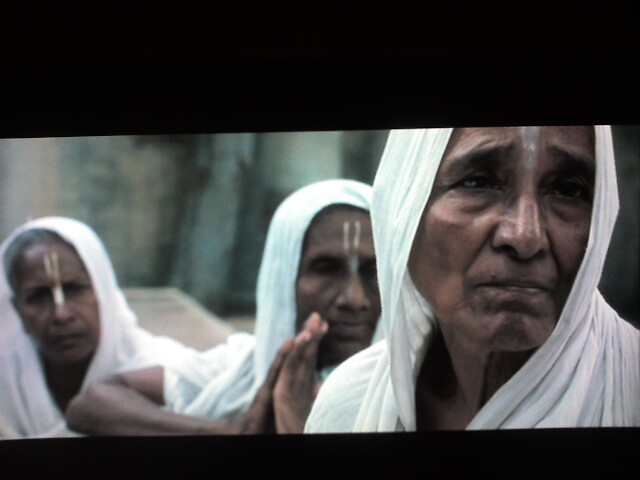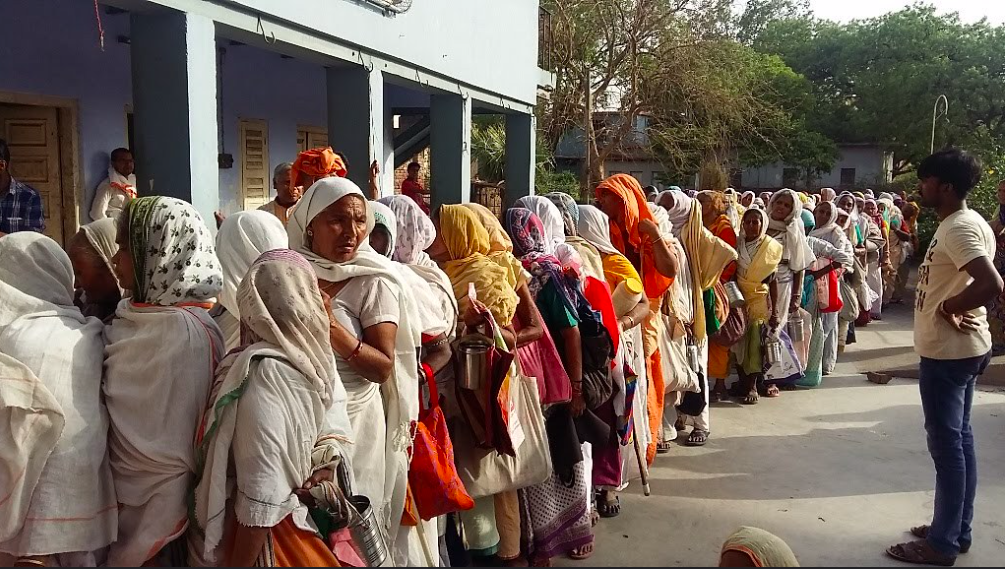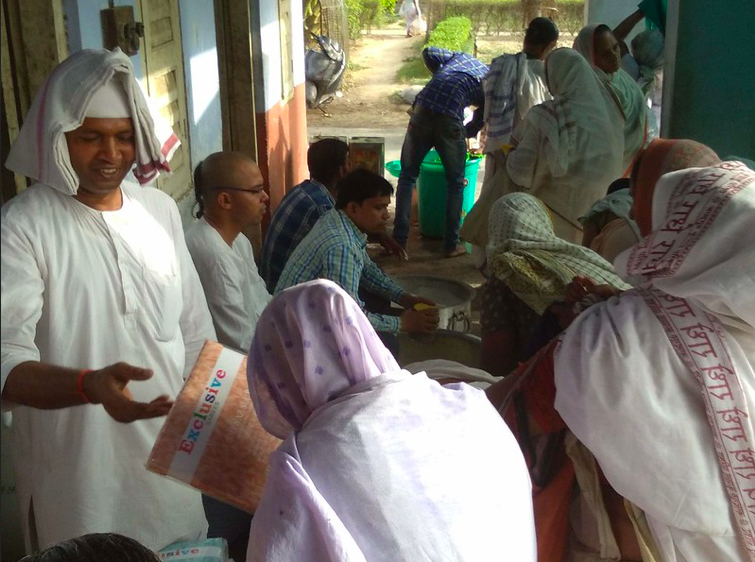By Aastha Tiwari

The unpaved dark alleys, amidst mud puddles and fresh cow dung on the street, the imagery created tends to invoke happiness, but alongside, the weight of tears that are shed by widows everyday invoke helplessness and grief. Women, of all ages, who have lost their husbands are stigmatised, shunned and shamed by society and perceived as ‘inauspicious’. The very visual that is created in our minds everytime we hear the word ‘widow’ is of a woman draped in white plain saree, deprived of jewellery of any kind, denied the right to beauty that is considered to be a treasure for a married woman and an expression of femininity.
The shadow of a widow charges the atmosphere with misfortune that might befall on sumangali women (married ones). Widowed women are abandoned, ostracised and discriminated at every step of their life. Their miseries increase manifold by virtue of their gender. Sometimes, widows believe that their life would have been a bit better if they weren’t born as the “oppressed sex”. The customs and traditions aggravate their situation by throwing them into the den of social isolation. This is particularly devastating for teenage widows who lose all their freedom, agency over their life and are coerced to buckle under the societal framework that in all its manifestation is exclusionary and triggering.
In this wretched world with no apathy for widows, they seek to find their solace in the holy pilgrimage centre of Vrindavan. India is flooded with countless number of holy pilgrimage centres, by virtue of it being a diverse nation where religion is a part and parcel of everyone’s life. Vrindavan, a holy town in Mathura, on the banks of Yamuna that entices thousands of pilgrims every year, is closely associated with the birth of Lord Krishna who is believed to have spent his childhood there. The dust of the place is considered to be pure and holy which people smear on their forehead. This in itself speaks of the sanctity of Vrindavan. It is widely believed that the Divine child Krishna tricked with his Gopis in the lanes of Vrindavan where the most surreal love story blossomed between Krishna and Radha. In this temple-crammed town, the name of these two sweethearts is on everybody’s lips. Pilgrims come to the holy center to seek solace and mental peace, bathing in the river Yamuna, walking along the sacred groves (woods).

As said, there is always another side to everything, Vrindavan’s darker, less-cherished side is its popular connotation as “the city of widows”, which houses thousands of widows who have been either cast away by their families and are all alone in this unequal and unjust world or they subordinate themselves and renounce their wealth for the sake of their families, driven by the socially manufactured customs.
Although widows in India don’t throw themselves on the funeral pyre of their husbands, life is still hard on them. With nobody’s back to support them, they set their mind to explore the arduous path that life has to offer. They are often seen begging on streets, singing bhajans and doing kirtans in temple for a meager amount of Rs 20 that doesn’t even suffice for one meal. They depend on bhandaras for one proper meal. It is never known why this city particularly attracts so many widows, especially from Bengal. Some genuinely come to devote themselves in the worship of Krishna and Radha while others see it as an escape from the brutal onslaught meted out to them by their families, children and society. They are demonised to an extent where they run away from their own lands where they grew up in. It sounds hideous and outrages our soul, but this is the reality that circumscribes the life of widows in this holy city. All widows, in totality, share the same story of hardships and ordeals that is characteristic of their life.
These widows live in an ashram that is like a spiritual commune, but they have to resort to begging for accommodation. This epitomises their everyday struggle in this harsh world. They run away from their houses, only to be met with the same rough demeanour of people who despise their existence. For some, to even cast an eye on a widow is considered to be a bad omen. Their life in Vrindavan involves sitting cross-legged sharing their lived experiences, in the dim light, moving like schools of fish, hurrying together and pouting around streets in dozens. Everyday seems like a long year that surmounts their life with toxicity. Given this abrasive treatment, some put up the garb of being feisty and fierce while others are afraid, broken and shattered. The government’s lack of diligence speaks a lot about their political worth. Since they are less in number, they are on nobody’s card, so not much attention is paid to their grievances.

In 2012, the Supreme Court took cognisance of the plight of the widows, questioning the work of agencies and the government’s inaction in alleviating the distress of the widows, on the basis of a PIL filed by National Legal Services Authority Charity which stated that when a widow died, her body was chopped into pieces and thrown like a garbage in the rivers of Yamuna as there was no money for their last rites. The court ordered the setting up of a special committee to identify the widows in Vrindavan- those with/without shelter. It also ordered a complete collection of data on the widows- their reasons for leaving, income etc. and improvement in infrastructure. Life became easier after court intervention but there are still miles to go.
The court then asked NALSA to approach ‘Sulabh International’, the largest NGO for providing better services and care, after which Dr. Bindeshwar Pathak stepped in. They assisted by providing financial help, as the major that concern widows face is their inability to access monthly allowance that the government lends them. Illiteracy and physical disability constrain them from availing this benefit. They provide money directly to the widows so that they have control over it, an agency to use money the way they want to. Apart from material benefits, they also help them to retreat from the unpleasantness by showering love, comfort and affection. This is made explicit in the smallest of things like Playing Holi or Diwali with them. The baggage of societal stigma leads the minds of windows into thinking that festivals are no more a part of their life. The NGO allows them to escape from this oppressive tradition and mentality.
These servants of God who devote their entire life in the service of these deities appear to live tragic lives on the holy streets of this romance-drenched town. ‘Sulabh’, like many other non-governmental organisations, are working towards ameliorating the conditions of widows, but they have been unable to quell the injustices and age-old superstitions. Things are definitely better than they were before. There is a change in the way widows are perceived today, although it is largely in an urban context. There is a development of a sense of belongingness in the hearts and minds of widows. There are indications of material progress, but the fight against societal stigma and taboos is a long one. Their existence is aggravated because of the design of the society that we live in. Patriarchy is so deeply ingrained that it allows men to take a second wife but stigmatises the woman if she remarries. These stigmas confine the widows within the stinky walls of stereotypes and closed rooms painted in faded white that mirrors their miserable life. As Robert Frost says “There are miles to go before we sleep”, likewise, a lot more needs to be done. As long as women are ostracised and stigmatised after their husbands’ death, widows will suffer. We need to collectively fight patriarchy and cleanse the society of.
Content writer Aastha tiwari is a girl who is stating at the clouds from the window sill listening to Surjan Stevens while contemplating the metaphorical undertones coloring the cloud. Role: Content Writer.Educational Qualification: Second year Political science major.Ultimate Goal: UPSC.Biggest achievement: Being featured as the writer of the month for Feminism In India.


